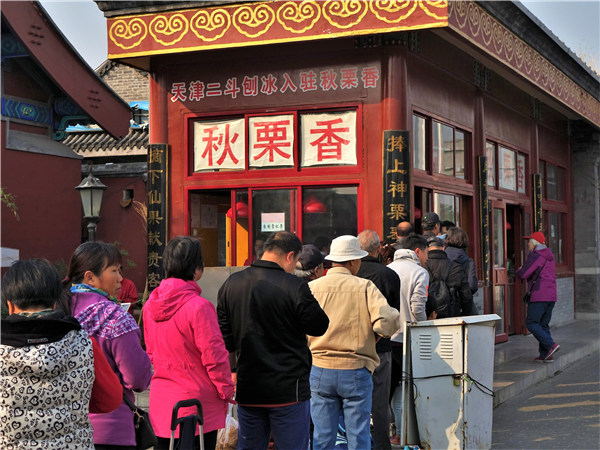 |
|
Roasted chestnuts are a common street food in China during fall and winter, where they are sold outdoors in many towns and at street intersections. [Photo provided to China Daily] |
Chinese chestnuts are winter snacks. Whole nuts are snipped at the bottom end to prevent them exploding during cooking and then roasted in a mixture of sand and sugar. They are sifted clean before being sold but are still characterized by the slightly gritty sticky shells. These sweet chestnuts, a deep chocolate brown and glistening with sugar glaze, are a real treat.
They used to be hand fried in huge iron woks, with the vendors perspiring over the hot sand mixture, in spite of the winter chill. The sand helps to increase the heat needed to pop the nuts open.
These days, chestnuts are mostly roasted in automated steel drums that rotate, rustling noisily at each turn.
Holding a bag of hot chestnuts warms both hands and heart. And, because of the high carbohydrate content, the nuts also provide heat to the body.
As the nuts cool quickly in the chilly temperatures of winter, they become easier to crack and peel, their dark brown skin coming away from the creamy yellow flesh like paper.
Chestnuts are also used for cooking.
They are one of the ingredients for the classic Eight Treasures Duck, together with lotus seeds, shiitake mushrooms, Chinese sausages, leeks, scallions, pine nuts and sticky rice. You can say this is the Chinese equivalent of stuffed turkey.
Chinese chefs go one better. The duck is carefully boned before the filling is stuffed into the bird, steamed and then flash fried to crisp the skin before serving. Sometimes, the duck is tied at the neck and at the waist to shape it into a bottle gourd, or hulu, a symbol of good fortune and longevity.
Another classic dish is braised chicken and chestnuts in an onion gravy. It is an extremely popular home-cooked dish when fresh chestnuts are in season.
Unlike the French, the Chinese are traditionally less likely to use chestnuts in patisserie, but the new coffee clubs and cake houses in the cities are now pushing out a popular cake topped with candied chestnut puree similar to marron glacé. This pastry first originated in Hong Kong and was in turn inspired by the classic French Mont Blanc.
Chestnuts are also dried. The dehydrated nuts meant chefs could use the nuts all year round, simply soaking them in water before cooking. Dried chestnuts are sold in Chinatowns all over the world.
During the fifth lunar month when rice dumplings are prepared for the Dragon Boat Festival, dried chestnuts fly off the shelves. Every savory dumpling will always need one or two chestnuts to complete the filling.
Like most Chinese ingredients, chestnuts are valued for their medicinal properties.
Traditional Chinese medicine prescriptions use chestnuts for stomach ulcers and to whet appetites. They are believed to be a "yang" food and therefore good for virility. Taken in moderation, they aid blood flow and increase "qi" in the body.
It is also food for the ladies, having the ability to combat anemia and improve complexions.
That's very comforting to know, and for once I'm sure, most will gladly take the prescriptions and enjoy them too.